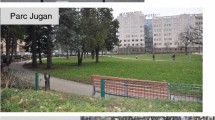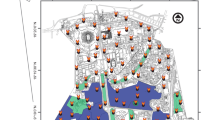Abstract
In the urban landscape of develo** countries like India, three species, i.e., humans, cattle, and dogs coexist and interact regularly. In the current study, we evaluated the intra- and interspecific interactions with special reference to street cattle in an urban area. We conducted the study at ten different locations in Raipur City and observed different types of possible interactions. We found licking and butting as the most frequent positive and negative intraspecific interactions, respectively among individuals of the street cattle population. The frequency of neutral interaction among the three species is statistically significantly higher than either positive or negative interactions. The positive interaction between cattle and dogs was more than the negative interaction. But, in the case of cattle-human interactions, the negative interaction was greater than the positive interaction. A statistically significant time-of-day variation was noticed in the licking, playing, mounting, pushing, and butting behavior under the intraspecific interaction category in the cattle. The negative interaction of cattle with dog and human, human towards cattle, positive interaction of dog towards cattle, and neutral interactions between cattle-dog and cattle-human also exhibited time-of-day variability. In conclusion, all three species coexist in the urban landscape with a markedly higher frequency of neutral interaction followed by negative interactions among them. For the welfare of all three species minimization of dum** of open garbage is recommended as one of the key strategies to overcome the cattle and dogs menace on the urban streets of India and elsewhere.


Similar content being viewed by others
Data availability
Data generated during this study are available as supplementary files.
References
19th Livestock Census (2012) All India report: ministry of agriculture, department of animal husbandry, dairying & fisheries, Krishi Bhawan, New Delhi, India. http://dahd.nic.in/sites/default/filess/Livestock%20%205_0.pdf. Accessed 11 February 2019
20th Livestock Census (2019) All India report: ministry of agriculture, department of animal husbandry, dairying & fisheries, Krishi Bhawan, New Delhi, India. https://dahd.nic.in/sites/default/filess/Re-Designation%20of%20Sh%20Sanjay%20Bhoosreddy,Joint%20Secretary.pdf. Accessed 13 December 2019
Arya S, Swain RK, Nayak HK, Pati AK (2020) Circadian variations in foraging and resting/standing activity patterns of stray street cattle of urban Sambalpur, Odisha. India Biol Rhythm Res 51(7):1053–1065. https://doi.org/10.1080/09291016.2019.1573461
Baquero OS, Akamine LA, Amaku M, Ferreira F (2016) Defining priorities for dog population management through mathematical modeling. Prev Vet Med 123:121–127. https://doi.org/10.1016/j.prevetmed.2015.11.009
Beck AM (2002) The ecology of stray dogs: a study of free-ranging urban animals. Purdue University Press, ISBN, p 1557532451
Burghardt GM (2005) The genesis of animal play: Testing the limits. MIT Press
Cambridge Dictionary (2020) Sucking. https://dictionary.cambridge.org/dictionary/english/sucking. Accessed 5 August 2020
Chhabra K (2021) Chhattisgarh Godhan Nyay Yojana 2021. https://sarkariyojana.com/godhan-nyay-yojana/. Accessed 18 November 2021
Coleman PG (2002) Zoonotic diseases and their impact on the poor. Investing in animal health research to alleviate poverty. Nairobi Intern Lives Res Ins 1–29
Cook R (2023a) Ranking of countries with the most cattle. https://beef2live.com/story-world-cattle-inventory-ranking-countries-0-106905. Accessed 31 May 2023a
Cook R (2023b) Ranking of countries that export the most beef (USDA). https://beef2live.com/story-world-beef-exports-ranking-countries-0-106903. Accessed 23 July 2023b
Cortez-Aguirre GR, Jiménez-Coello M, Gutiérrez-Blanco E, Ortega-Pacheco A (2018) Stray dog population in a city of southern Mexico and its impact on the contamination of public areas. Vet Med Int 2018:1–6. https://doi.org/10.1155/2018/2381583
Datta D (2014) India's toxic milk and plastic cows. https://www.indiatoday.in/india/north/story/india-toxic-milk-and-plastic-cows-17-9525-2014-02-03. Accessed 26 July 2023
Encyclopaedia Britannica (2020) Dominance hierarchy. Animal behavior. https://www.britannica.com/science/dominance-hierarchy. Accessed 5 August 2020
End Pet Homelessness Index (2021) State of Pet Homelessness Index. https://endpethomelessness.com/the-index. Accessed 29 November 2021
Gompper ME (2014) The dog-human-wildlife interface: assessing the scope of the problem. In: Gompper ME (ed) Free-ranging dogs and wildlife conservation, 1st edn. Oxford University Press, New York, pp 9–54
Gowen A (2018) Why India has 5 million stray cows roaming the country. The Washington Post. https://www.washingtonpost.com/world/2018/07/16/amp-stories/why-india-has-million-stray-cows-roaming-country/. Accessed 6 April 2019
Hegland SJ, Boeke L (2006) Relationships between the density and diversity of floral resources and flower visitor activity in a temperate grassland community. Ecol Entomol 31:532–538. https://doi.org/10.1111/j.1365-2311.2006.00812.x
Holden SA, Butler ST (2018) Review: Applications and benefits of sexed semen in dairy and beef herds. Animal 12:97–103. https://doi.org/10.1017/S1751731118000721
India population (2019) The population of Raipur in 2019. https://indiapopulation2019.com/population-of-raipur-2019.html. Accessed 13 August 2019
Kukreti I (2018) India sees 1.75 million dog bites every year, yet we face up to 80% shortage of anti-rabies vaccines. https://www.downtoearth.org.in/news/health/india-sees-1-75-million-dog-bites-every-year-yet-we-face-up-to-80-shortage-of-anti-rabies-vaccines-61298. Accessed 1 August 2020
McDaniel CJ, Cardwell DM, Moeller RB Jr, Gray GC (2014) Humans and cattle: a review of bovine zoonoses. Vector Borne Zoonotic Dis 14(1):1–19. https://doi.org/10.1089/vbz.2012.1164
Miller LJ (2017) Creating a common terminology for play behavior to increase cross-disciplinary research. Learn Behav 45:330–334. https://doi.org/10.3758/s13420-017-0286-x
Ministry of Road Transport and Highways, India (2019) Road Accidents in India. https://morth.nic.in/road-accident-in-india. Accessed 30 April 2021
Mueller MA, Drake D, Allen ML (2018) Coexistence of coyotes (Canis latrans) and red foxes (Vulpes vulpes) in an urban landscape. PLoS One 13:e0190971. https://doi.org/10.1371/journal.pone.0190971
Pal SK (2001) Population ecology of free-ranging urban dogs in West Bengal, India. Acta Theriol 46:69–78. https://doi.org/10.1007/BF03192418
Potratz EJ, Brown JS, Gallo T, Anchor C, Santymire RM (2019) Effects of demography and urbanization on stress and body condition in urban white-tailed deer. Urban Ecosyst 22:807–816. https://doi.org/10.1007/s11252-019-00856-8
Press Information Bureau Government of India (2023) Milk production in India. https://pib.gov.in/FeaturesDeatils.aspx?NoteId=151137&ModuleId%20=%202. Accessed 23 July 2023
Punjabi GA, Athreya V, Linnell JDC (2012) Using natural marks to estimate free-ranging dog Canis familiaris abundance in a mark-resight framework in suburban Mumbai. India Trop Conserv Sci 5(4):510–520. https://doi.org/10.1177/194008291200500408
Ramaswamy V, Sharma HR (2011) Plastic bags –threat to environment and cattle health: a retrospective study from Gondar city of Ethiopia. IIOAB Journal 2:7–12
Reese JF (2005) Dogs and dog control in develo** countries. In: Salem DJ, Rowan AN (eds) the state of the animals III. Humane Society Press, Washington, DC, pp 55–64
Reinhardt V, Mutiso FM, Reinhardt A (1978a) Social behaviour and social relationships between female and male prepubertal bovine calves (Bos indicus). Appl Anim Ethol 4:43–54. https://doi.org/10.1016/0304-3762(78)90092-5
Reinhardt V, Mutiso FM, Reinhardt A (1978b) Resting habits of Zebu cattle in a nocturnal enclosure. Appl Anim Ethol 4:261–271. https://doi.org/10.1016/0304-3762(78)90116-5
Reinhardt V, Reinhardt A (1981) Cohesive relationships in a cattle herd (Bos indicus). Behavior 77:121–150. https://doi.org/10.1163/156853981X00194
Sahu BK, Parganiha A, Pati AK (2019) Spatiotemporal variability in activity patterns of urban street cattle as a function of environmental factors. Chronobiol Int 36:1362–1372. https://doi.org/10.1080/07420528.2019.1644345
Sahu BK, Parganiha A, Pati AK (2020) Time-of-day and seasonal variations in foraging behavior of street cattle of urban Raipur. India Biol Rhythm Res 53(5):1–15. https://doi.org/10.1080/09291016.2020.1794646
Sahu BK (2021) Wandering and foraging behavior of street cattle around urban Raipur, Chhattisgarh. Ph.D. Thesis. Pandit Ravishankar Shukla University, Raipur (India). pp 1–259
Sahu BK, Parganiha A, Pati AK (2021) A population estimation study reveals a staggeringly high number of cattle on the streets of urban Raipur in India. PLoS One 16(1):e0234594. https://doi.org/10.1371/journal.pone.0234594
Sandem AI, Braastad BO (2005) Effects of cow-calf separation on visible eye white and behaviour in dairy cows - A brief report. Appl Anim Behav Sci 95:233–239. https://doi.org/10.1016/J.APPLANIM.2005.04.011
Santini L, González-Suárez M, Russo D, Gonzalez-Voyer A, von Hardenberg A, Ancillotto L (2019) One strategy does not fit all: determinants of urban adaptation in mammals. Ecol Lett 22:365–376. https://doi.org/10.1111/ele.13199
Singh B (2005) Harmful effect of plastic in animals. Indian Cow: the Scientific and Economic Journal 2(6):10–18
Solano J, Orihuela A, Galina CS, Montiel F, Galindo F (2005) Relationships between social behaviour and mounting activity of Zebu cattle (Bos indicus). Appl Anim Behav Sci 94:197–203. https://doi.org/10.1016/j.applanim.2015.04.004
Stammbach E (1979) On social differentiation in groups of captive female Hamadryas baboons. Behaviour 67:322–338. https://doi.org/10.1163/156853978X00387
The Economic Time (2022) Over 900 deaths in accidents caused by stray cattle in Haryana in 5 years. https://economictimes.indiatimes.com/news/india/over-900-deaths-in-accidents-caused-by-stray-cattle-in-haryana-in-5-years/articleshow/93473876.cms. Accessed 23 July 2023
Thurman CL, Broghammer AM (2001) Locomotor activity of the fiddler crab, Uca subcylindrica (Stimpson), under artificial illumination. Biol Rhythm Res 32:85–99. https://doi.org/10.1076/brhm.32.1.85.7282
Totton SC, Wandeler AI, Zinsstag J, Bauch CT, Ribble CS, Rosatte RC, McEwen SA (2010) Stray dog population demographics in Jodhpur, India, following a population control/rabies vaccination program. Prev Vet Med 97:51–57. https://doi.org/10.1016/j.prevetmed.2010.07.009
Vaktania S (2023) Gujarat govt to sterilize over 50,000 bulls to curb stray cattle menace. India Today. https://www.indiatoday.in/india/story/gujarat-news-castration-of-bulls-stray-cattle-menace-bull-sterilization-2320519-2023-01-12. Accessed 23 July 2023
Veissier I, Le Neindre P, Garel JP (1990) Decrease in cow-calf attachment after weaning. Behav Processes 21:95–105. https://doi.org/10.1016/0376-6357(90)90018-B
World Health Organization (2017) One Health. WHO. https://www.who.int/news-room/questions-and-answers/item/one-health. Accessed 23 July 2023
Wilson SC, Dobos RC, Fell LR (2005) Spectral analysis of feeding and lying behavior of cattle kept under different feedlot conditions. J Appl Anim Welf Sci 8:13–24. https://doi.org/10.1207/s15327604jaws0801_2
Yamada M (1963) A study of blood-relationship in the natural society of the Japanese macaque. Primates 4:43–65. https://doi.org/10.1007/BF01733671
Acknowledgements
This work is a part of the Doctor of Philosophy thesis of one of the authors (BKS). We are grateful to the University Grants Commission, New Delhi, for support through its DRS-SAP scheme sanctioned in the thrust area—Chronobiology to the School of Studies in Life Science, Pandit Ravishankar Shukla University, Raipur. We are also thankful to the Municipal Corporation of Raipur, India, for their cooperation and for providing us with the data on dustbin installations and a map of Raipur city. We record our special thanks to Mr. Radhe Lal Markam for assisting us during the field study. The Head of the Department, School of Studies in Life Science, Pandit Ravishankar Shukla University, Raipur obliged us by providing logistics support. We are also obliged to the anonymous reviewer for offering us valuable suggestions for the improvement of the manuscript.
Funding
This work was supported by the University Grants Commission, New Delhi, India under the scheme of Joint CSIR-UGC NET for Junior Research Fellowship [Sr. No. 2121530765. Ref. No: 20/12/2015 (ii) EU –V dated 18/05/2016] to BKS.
Author information
Authors and Affiliations
Contributions
All authors contributed to the study conception and design. Data collection and analysis were performed by BKS. The first draft of the manuscript was written by BKS and all authors commented on previous versions of the manuscript. All authors read and approved the final manuscript.
Corresponding author
Ethics declarations
Conflict of interest
The authors declare no competing interests.
Supplementary Information
Below is the link to the electronic supplementary material.
Rights and permissions
Springer Nature or its licensor (e.g. a society or other partner) holds exclusive rights to this article under a publishing agreement with the author(s) or other rightsholder(s); author self-archiving of the accepted manuscript version of this article is solely governed by the terms of such publishing agreement and applicable law.
About this article
Cite this article
Sahu, B.K., Pati, A.K. & Parganiha, A. Intra- and interspecific interactions in the Indian urban ecosystem with special reference to street cattle as the pivot. Urban Ecosyst 26, 1829–1842 (2023). https://doi.org/10.1007/s11252-023-01423-y
Accepted:
Published:
Issue Date:
DOI: https://doi.org/10.1007/s11252-023-01423-y




